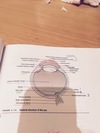page 188 to 197 Flashcards
short loop of henle
cortical nephron
intermediate nephron
medium loop of henle
long loop of henle
juxtamedullary nephron
travels from urinary bladder through prostate gland
prosteatic urethra
widest and most dilatable
prostatic urethra
membranous urethra
end of prostate through body wall to penis
shortest and least dilatable
membranous urethra
penile urethra
travel length of penis within corpus spongiosum
longest and narrowest
penile urethra
short(3-5 cm)
extends from urinary bladder to vaginal vestibule
female urethra
make sperm and steroids
testis
thick CT over Testes
tunica albuginea
many lobules and
1-4 sem. tubules
testes
site of spermatogenesis
sem. tubules
sits on post testes
has ductus epididymis
stores sperm
epipdydimis
ep cell have sterocilia which inc SA for nutrient absorption for sperm
epididymis
seminal fluid
secretions from seminle vesicles
and prostate
in sem. tubules
leydig and sertoli cells
producte test; produce test fluid
leydig to sertoli cells
sperm cels
produced in sem. tubules but mature and are stored in epididymis
produce sperm
sperm cells
sem tubule
eff ductule
duct deferans join seminal vesicle duct
sem tubule
rete testes
eff ductule
ductus epididymis
duct deferans join seminal vesicle duct
ejac duct
surrounds proximal urethra
prostate gland
secretes acid phosphatase
fibrinolysin
citric acid
prostate gland
3 major masses of tissue surrounded by dense fibroelstic capsule(tunica albuginea)
penis
corpora cavernosa
2 dorsal sections of erectile tissue
corpus spongiosum
one ventral section with urethra
elliptical organ supported by broad lig of uterus
ovary
make ova and steroids(estrogen and progesterone)
ovary
inner medulla of ovary
vasc, nerve , cT
contains ov. follicle and site of oogenesis
outer cortex of ovary
bilat from ovaries to uterus
oviduct
adjacent to ovary
has fingerlike extensions carlled fimbriae
infidibulum
ampulla
longest secton of oviduct
site of fertilization
adjacent to uterus
isthmus
opening to uterus
uterine
sit eof embryonic and fetal development
uterus
endometrium
muc. layer shed during menustration
thickestlayer with SM
myometrium
perimetrium
ext layer with CT
has uterine gland
uterus
cervix
lower section of uterus connecting it to vagina
its mucosa isnt shed during menustrtion
uterus
vagina
lined with non ker. strat sq. ep
doesnt contain glands
vagina
mamm gland
has tubuloalveolar glands
seb glands
sweat glnds
milk
made by merocrine and apocrine secretions
lactation
reg. by sex hormones produced during pregnancy and is under control of pit and hyp.
protect agaisnt phys, chem, biological agents
skin
touch pain presure
snesory function of skin
homeostasis
reg body temp and water loss
function of skin
vit d from UV light
skin synthesize
strat sq. ker. ep
epidermis
ep mitotic activty
melanocyte, keratinocyte, other special cells
least cytodiff.
stratum basale
cub to low columnar
stratum basale










